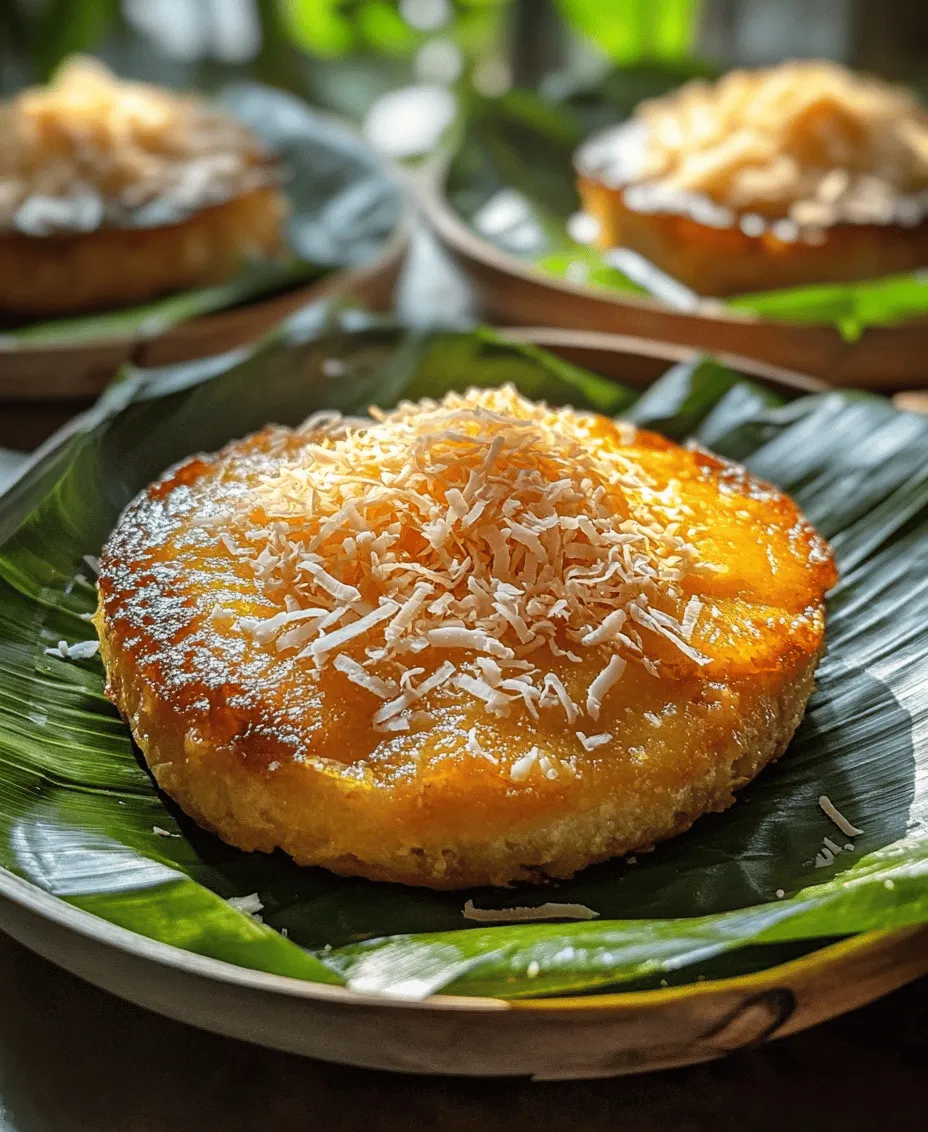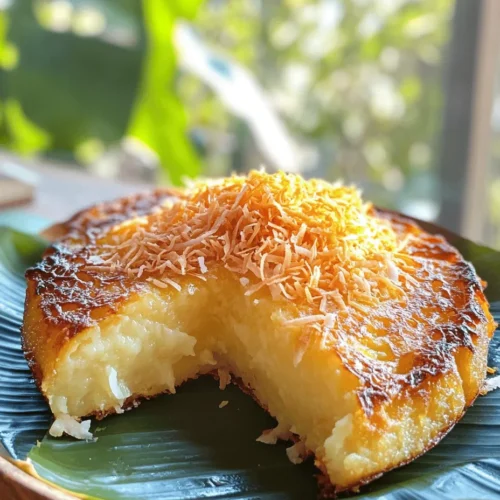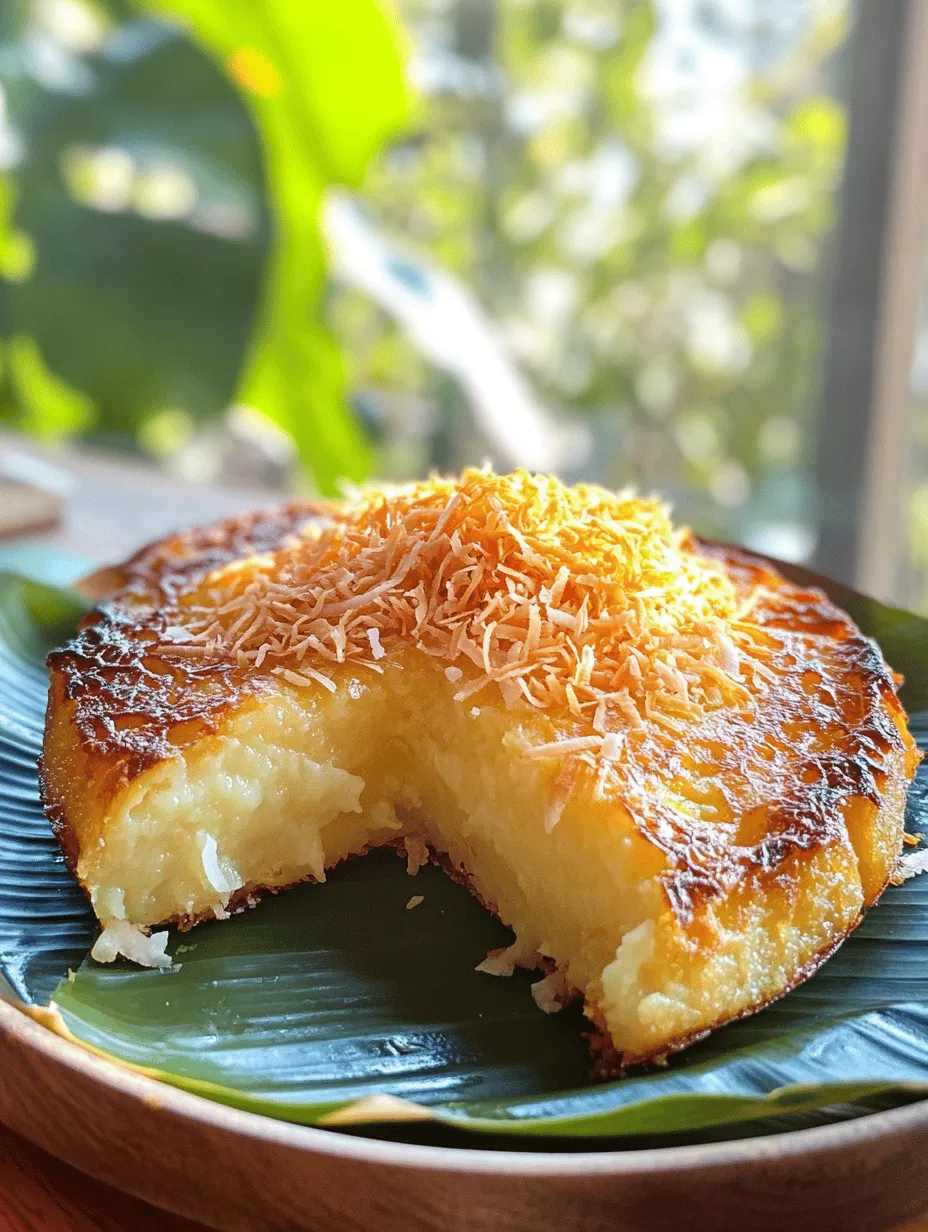Introduction
Bibingka is not just a dessert; it’s a beloved traditional Filipino delicacy that evokes nostalgia, especially during the festive season. Originating primarily from the provinces of the Philippines, this rice cake is often associated with the Christmas holiday, specifically during the traditional Simbang Gabi or Night Masses. As the sweet aroma of bibingka fills the air, it brings warmth to the hearts of many Filipinos, making it a staple during family gatherings and celebrations.
At the heart of this delightful treat lies coconut, a fundamental ingredient in Filipino cuisine. Coconuts are revered for their versatility and abundance in the Philippines, contributing to a wide range of dishes and desserts. In bibingka, coconut plays a crucial role, enriching the cake with its creamy texture and subtle sweetness, which complements the other flavors beautifully.
This Heavenly Coconut Bibingka recipe showcases a unique blend of flavors and textures that makes it irresistible. The soft, moist cake, combined with the slight chewiness from the coconut, creates a delightful experience for anyone who takes a bite. With the addition of optional ingredients such as cheese and salted eggs, this bibingka offers layers of flavor that are both familiar and exciting. Let’s dive deeper into the world of bibingka and discover the elements that make this dish so special.
Understanding Bibingka
Bibingka, in its most basic form, is a rice cake made primarily from rice flour, coconut milk, and sugar. It is traditionally cooked in clay pots lined with banana leaves, giving it a distinct aroma and flavor that cannot be replicated with modern baking techniques. The use of banana leaves not only adds flavor but also helps to keep the cake moist during the cooking process.
The history of bibingka can be traced back to pre-colonial times, where it was made from ground glutinous rice. As the Philippines experienced various influences, particularly during the Spanish colonial period, bibingka evolved into the delicious treat we know today. It became a symbol of Filipino culture, often served during important celebrations such as Christmas, weddings, and fiestas.
Different regions across the Philippines have their own variations of bibingka, each with unique ingredients and cooking methods. For instance, in Batangas, bibingka is often topped with butter and sugar, while in Pampanga, it may include salted eggs and cheese for an added savory twist. These regional variations highlight the adaptability of this dish, allowing it to be tailored to local tastes and traditions.
Ingredients Breakdown
To recreate the authentic taste and texture of Heavenly Coconut Bibingka, it is essential to understand the role of each ingredient in the recipe. Below is a detailed analysis of the main ingredients used in this bibingka recipe:
Rice Flour
Rice flour is the foundation of bibingka, providing its signature texture. Unlike wheat flour, rice flour is gluten-free, which results in a denser and chewier cake. This characteristic is particularly appealing in bibingka, as it allows the cake to maintain its shape while still being soft and moist. Furthermore, rice flour has a neutral flavor that lets the other ingredients shine, particularly the coconut.
Coconut Milk
Coconut milk is a vital component of this recipe, contributing to the richness and moisture that makes bibingka so delectable. It is made by blending grated coconut with water and straining the mixture to extract a creamy liquid. The use of coconut milk not only enhances the flavor profile but also adds a unique creaminess that elevates the overall eating experience. It is important to use high-quality coconut milk to ensure the best results; look for brands that do not contain additives or preservatives.
Fresh vs. Desiccated Grated Coconut
Coconut can be used in two forms in this bibingka recipe: fresh grated coconut and desiccated coconut. Fresh grated coconut offers a more pronounced flavor and chewy texture, making each bite more enjoyable. It also adds moisture to the cake, contributing to the overall richness. On the other hand, desiccated coconut is dried and has a more concentrated flavor, which can enhance the cake’s sweetness. Depending on availability and personal preference, either option can be used, or a combination of both can be employed for a more complex flavor profile.
Sugar
Sugar serves as a key ingredient in bibingka, balancing the flavors and providing sweetness. In this recipe, granulated sugar is commonly used, but alternative sweeteners like coconut sugar can also be substituted for a more natural flavor. The amount of sugar can be adjusted according to personal taste preferences, but it is essential to keep in mind that sugar not only adds sweetness but also contributes to the browning of the cake during baking.
Baking Powder
Baking powder is crucial for achieving the right texture in bibingka. It acts as a leavening agent, helping the cake to rise and become fluffy. The chemical reaction caused by baking powder produces carbon dioxide, which creates air pockets in the batter, resulting in a light and airy texture. When using baking powder, be sure to check the expiration date, as old baking powder may not provide the desired lift.
Eggs
Eggs play a significant role in binding the ingredients together while also enriching the batter. They contribute to the overall structure of the cake and provide moisture. Additionally, eggs help in achieving a beautiful golden color on the surface of the bibingka. While the recipe typically calls for large eggs, it is essential to ensure they are at room temperature for better incorporation into the batter.
Optional Ingredients: Cheese and Salted Eggs
For those looking to add an extra layer of flavor to their bibingka, optional ingredients like cheese and salted eggs can take it to the next level. Cheese, particularly grated cheese like queso de bola or cheddar, adds a savory note that beautifully contrasts the sweetness of the cake. Salted eggs, known as “itlog na maalat,” contribute a unique flavor and texture that many find irresistible. When used as toppings, both ingredients not only enhance the taste but also add visual appeal to the finished product.
With this understanding of the ingredients that create the Heavenly Coconut Bibingka, we can now move on to the actual recipe and cooking process. This delightful treat is not just about the flavors; it’s also about the joy of making it and sharing it with loved ones.
Stay tuned for the next part of this article, where we will guide you through the step-by-step instructions to make your own Heavenly Coconut Bibingka, ensuring that you can enjoy this Filipino delight in the comfort of your home.

Preparation Steps for Heavenly Coconut Bibingka
Creating the perfect Heavenly Coconut Bibingka starts with meticulous preparation. Each step is crucial to ensure that the final product is not only delicious but also visually appealing. Here’s how to prepare this delightful Filipino rice cake that promises to transport you straight to a tropical paradise.
Prepping the Baking Dish
To achieve the authentic taste and texture of bibingka, using banana leaves or parchment paper is essential. Banana leaves impart a unique flavor to the cake while preventing it from sticking to the pan. If you can find fresh banana leaves, clean them thoroughly and soften them by briefly passing them over an open flame. This makes them pliable and easier to work with.
If banana leaves are unavailable, high-quality parchment paper is a suitable alternative. Line your baking pan with either option, ensuring it covers the sides as well. This preparation not only adds flavor but also helps in easy removal of the bibingka after baking.
Mixing Dry Ingredients
In a large mixing bowl, combine the dry ingredients: rice flour, baking powder, salt, and sugar. Whisk them together until they are fully integrated. This step is crucial for achieving a uniform texture in your bibingka. Ensuring that the dry ingredients are evenly distributed prevents any lumps from forming and guarantees that the cake rises properly during baking.
Consider using a fine-mesh sieve to sift the flour; this helps aerate the mixture, resulting in a lighter, fluffier bibingka. Make sure to set this bowl aside while you prepare the wet ingredients.
Combining Wet Ingredients
In a separate bowl, whisk together the wet ingredients: coconut milk, eggs, and melted butter. For a smooth batter, it’s important to mix these ingredients thoroughly before combining them with the dry mixture. This step is crucial as it ensures even distribution of flavors throughout the cake.
When mixing, allow the melted butter to cool slightly before incorporating it into the egg and coconut milk mixture to avoid cooking the eggs. Aim for a creamy consistency, as this will contribute to the overall moistness of the bibingka.
Incorporating Flavors
Once your wet ingredients are well combined, it’s time to introduce the grated coconut. Use fresh, finely grated coconut for the best flavor, but if unavailable, unsweetened frozen coconut is a good substitute. Gently fold the grated coconut into the wet mixture to retain the light texture.
This is also the perfect time to add any optional ingredients that elevate your bibingka. For instance, you can fold in some shredded cheese for a savory twist or a dash of vanilla extract for enhanced sweetness. Be careful not to overmix; you want to keep the batter airy.
Layering the Batter
Now comes the fun part: layering! Pour half of the batter into your prepared baking dish, spreading it evenly across the bottom. Next, strategically place slices of salted eggs on top of this layer. The saltiness of the eggs complements the sweetness of the bibingka beautifully.
Follow this with the remaining batter, ensuring that the salted eggs are covered. This layering technique not only enhances the flavor but also creates an eye-catching presentation when serving. You may sprinkle a little more grated coconut on top for added texture before placing it in the oven.
Baking Process
Preheat your oven to 375°F (190°C) and place the bibingka in the center rack. Bake for about 30-35 minutes or until the top is golden brown and a toothpick inserted into the center comes out clean. Baking times may vary slightly depending on your oven, so keep an eye on it towards the end of the cooking time.
To ensure even baking, consider rotating the dish halfway through the baking time. This helps avoid any hot spots in the oven that could lead to uneven cooking.
Final Touches
Once the bibingka is baked to perfection, remove it from the oven and immediately brush the top with melted butter. This final touch not only adds flavor but also gives the bibingka a beautiful, glossy finish. Let it cool for a few minutes before serving, allowing the flavors to settle.
Serving Suggestions
Serving your Heavenly Coconut Bibingka is as important as the baking process itself. Here are some best practices and creative ideas to enhance your experience.
Best Practices for Serving Bibingka
Traditionally, bibingka is enjoyed warm. Slice it into wedges and serve it directly from the baking dish or transfer it to a decorative platter for an elegant presentation. You can garnish each slice with a sprinkle of grated coconut or a few additional salted egg slices for an inviting look.
Bibingka can be served as a snack or dessert and is often enjoyed during special occasions and holidays in the Philippines. A dusting of powdered sugar can add a touch of sweetness for those who prefer a dessert-like experience.
Topping Ideas
To elevate the flavor profile, consider adding various toppings. Freshly grated coconut, crumbled cheese, and even a drizzle of condensed milk can enhance the bibingka’s taste. For a more indulgent treat, serve it with a scoop of vanilla ice cream or a dollop of whipped cream on the side.
You can also experiment with toppings such as mango slices or a sprinkle of cinnamon for a unique twist.
Pairing Bibingka with Beverages
The right beverage can complement your bibingka beautifully. Traditional pairings include hot chocolate or a cup of strong coffee, which balances the richness of the cake. For a refreshing option, serve it with iced tea or fresh fruit juices, particularly mango or calamansi, both of which enhance the tropical vibe of the dish.
Nutritional Insights
Understanding the nutritional benefits of bibingka ingredients can help you appreciate this delightful cake even more.
Overview of Nutritional Benefits
Bibingka offers several nutritional benefits, primarily due to its main ingredients. Rice flour is gluten-free and provides a good source of carbohydrates, while coconut milk is rich in healthy fats and contains essential vitamins and minerals. Grated coconut adds dietary fiber, which is beneficial for digestion.
Eggs contribute protein and essential amino acids, making bibingka a filling option for snacks or breakfast. Overall, this dish can be a part of a balanced diet when enjoyed in moderation.
Discussing Portion Sizes and Dietary Considerations
While bibingka is a delicious treat, it’s essential to be mindful of portion sizes, especially if you’re watching your calorie intake. A typical serving size is about one wedge, which can satisfy your sweet tooth without overindulging.
For those with dietary restrictions, consider modifications. For a vegan version, replace eggs with flaxseed meal mixed with water, and use plant-based milk. You can also substitute refined sugar with natural sweeteners like honey or maple syrup.
Modifications for Healthier Versions
If you’re looking to lighten up your bibingka, consider these modifications:
– Use whole grain rice flour instead of white rice flour for added fiber.
– Substitute part of the coconut milk with almond or soy milk to reduce fat content.
– Reduce the amount of sugar in the recipe to suit your taste preferences without sacrificing flavor.
Conclusion
Making Heavenly Coconut Bibingka is not just about creating a delicious dish; it’s an experience that brings joy and satisfaction to both the cook and the diners. From the preparation to the final presentation, each step is infused with the rich culinary heritage of the Philippines, making bibingka a beloved delicacy that transcends generations.
This delightful rice cake serves as a reminder of the vibrant flavors and traditions that Filipino cuisine has to offer. As you embark on your own bibingka journey, we invite you to explore and embrace this culinary heritage. Share the love, gather your friends and family, and enjoy the heavenly taste of bibingka that will surely leave lasting memories on your palate.



